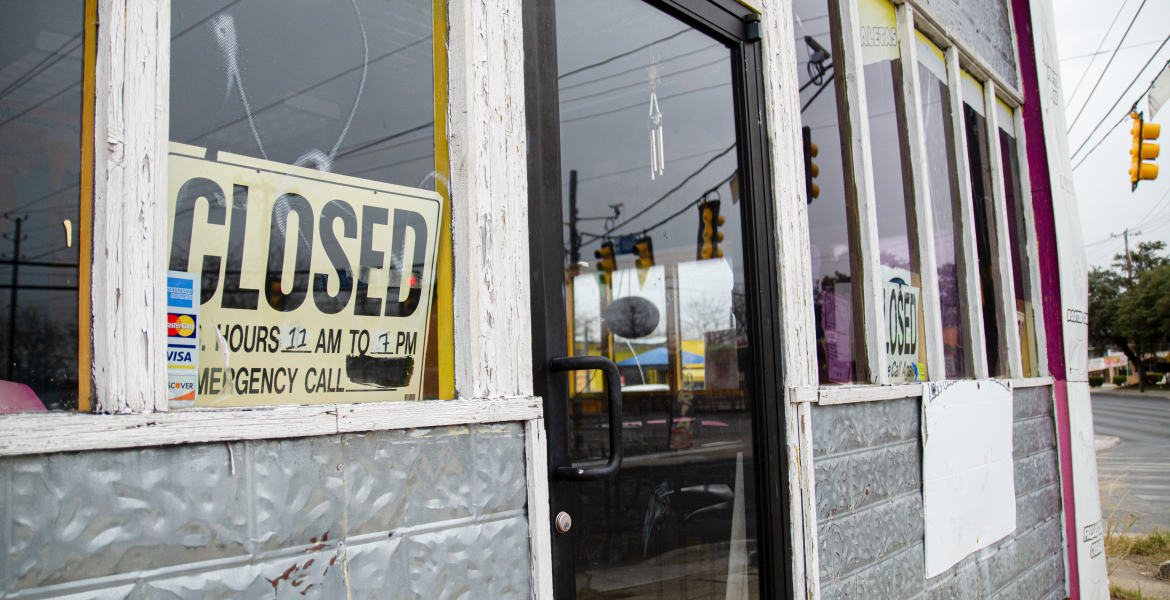Communications graduate Jason Wentworth, who has worked as a server for over 20 years, has experienced both the effects of the pandemic on restaurant employees and the rescinding of government assistance.
Wentworth works at a fine dining restaurant in downtown San Antonio and said his employer was very helpful after shutting down at the beginning of the pandemic by assisting employees with signing up for unemployment assistance through the Texas Workforce Commission.
When the restaurant reopened for only three days out of the week, Wentworth found his unemployment assistance was cut entirely when he could only work two shifts due to being a full-time student.
“Because I’m in school full time and I wasn’t picking up that extra shift, they cut my unemployment, which I don’t think is necessarily fair,” Wentworth said in a Nov. 24 interview. “I’m a little upset about that still. I don’t think they should have cut me off because I didn’t work one other day. Because my rent didn’t change, my bills are still the same.”
The U.S. labor market continues to crack under pandemic pressure as employee strikes and resignations spread across the nation in waves in recent months, and industries such as food service continue to suffer.
According to the Bureau of Labor Statistics, a total of 4.3 million workers quit their jobs by the end of August 2021.
The Labor Action Tracker, an online tool created by the School of Industrial and Labor Relations at Cornell University, recorded 57 strikes in October 2021, nearly double the average of every other month last year.
The terms “Great Resignation” and “Striketober” were coined to reflect these unprecedented numbers.
According to the Bureau of Labor Statistics, a total of 4.3 million workers quit their jobs by the end of August 2021.
Matthew Mangum, clinical assistant professor of business law and ethics at Texas A&M University-San Antonio, said with the labor market in turmoil there is “something strange” happening and he is not sure if anyone has fully figured out what is going on and when this will sort itself out.
“What is clear is that nearly every employee has had time to reflect on and reevaluate their jobs during the pandemic,” Mangum said. “Some because they had time away from the job, some because they had government income to support them for a while, some because the nature of their jobs changed so much and some because their jobs got much harder and more dangerous.”
According to the Washington Post article “Strikes are sweeping the labor market as workers wield new leverage” published Oct. 17, strikes were considerably higher last year because of a thinned labor pool, making the act of unionizing and striking less risky in the fight for improved labor conditions.
“Employees are hard enough to replace under normal times,” Mangum said. “But we know with the employee market the way it is, if you lose employees, if they go on strike, it’s going to be very difficult to replace them.”
Workers of Kellogg’s cereal plants went on an 11-week strike, starting on Oct. 5, according to the Washington Post. Workers seeked better pay and benefits after intense 12-hour shifts, seven days a week left them feeling overworked during the pandemic.
While the pandemic has continued to be a challenge for the U.S. economy, it has been difficult for the labor market to recover nearly two years later. Nearly all industries are struggling with returning to normal operations, with foodservice businesses being the more noticeable area affected.
As of November 2021, the restaurant industry’s unemployment rate was at 7.9%, remaining much higher than it was before the pandemic began, according to a CNBC article. With fewer applicants, restaurants have had to cut hours when possible or limit their services to adjust to understaffing.
James Moore, president of the Texas Restaurant Association’s San Antonio chapter and owner of Full Belly Cafe + Bar, said a lack of applicants being the most noticeable trend keeping restaurants from returning to normal operations.
Moore said the solution isn’t as easy as upping wages and providing additional benefits to bring in new hires. Despite many restaurants doing just that, “so many still choose not to work,” Moore said in an interview Nov. 30.
Rather than place the focus on higher wages as the solution to the labor shortage, Moore said there are other factors to consider such as the broken health care and college education systems which “keeps the foot on the neck” of the working class.
“The conversation is long overdue about what has to be done to get ahead in this country, and which opportunities exist for whom,” Moore said. “Ultimately folks need to work to provide for themselves and their families. I do believe that it is possible for all parties to win, but there are some fundamental changes necessary to happen first.”
Pandemic unemployment assistance ended for all states on Sept. 6 but for 23 states, including Texas, these benefits ended during the summer. Critics of these programs felt they were contributing to the labor shortage across the U.S.
Wentworth said he could empathize with those who are leaving their jobs in pursuit of something better and sees it as people “waking up to the fact that they are being underpaid and underappreciated,” especially in the restaurant industry where servers often have to deal with difficult people.
“I think that as a society, people leaving their jobs in order to find new opportunities is great because hopefully those people that are brave enough to do things like that, they do find something that makes them happy,” Wentworth said, “And at the same time the business owners who maybe aren’t paying a reasonable amount will start to understand, ‘If we want to keep employees, maybe we should give them a little more incentive financially.’”
Wentworth, who graduated in December, said he planned to eventually phase out of the service industry and is excited to not have to depend on waiting tables as his only source of income.
“I wait tables now not because it’s optional but because it’s the best paying job I can get without a degree,” Wentworth said. “But to get a degree and know that I have the option to wait tables or have a professional career where I can actually work my way up puts me in a happier mindset.”







